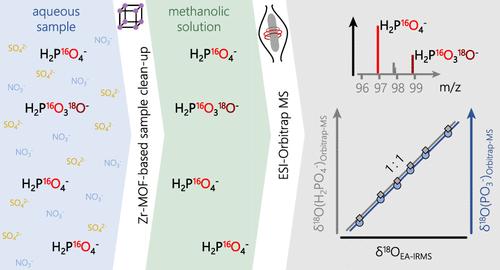电喷雾电离轨道阱质谱法分析磷酸盐和有机磷化合物的氧同位素
IF 6.7
1区 化学
Q1 CHEMISTRY, ANALYTICAL
引用次数: 0
摘要
Orbitrap质谱与电喷雾电离(ESI-Orbitrap MS)能够测量磷酸盐和有机磷化合物的18O/16O比率,为代谢、生物地球化学和环境过程的研究提供了有前途的途径。虽然这种18O/16O比值测量的仪器可行性已被证明,但这种分析在多用途质谱仪上在水性基质中的适用性仍未得到解决。在这里,我们(i)评估了仪器参数与ESI-Orbitrap MS从H2PO4 -和PO3 -磷酸片段中测定δ18O(PO4)的长期准确性和精密度之间的相互作用,(ii)确定了甲醇样品溶液的性质,这些性质对准确和精确的测量至关重要,(iii)提出了一种样品纯化程序,以消除基于基质的干扰。在两年多的10次测量中,我们观察到δ18O(PO4)的长期重复性在±2.8‰以内。H2PO4 -与PO3 -的源内破碎实验结果显示δ18O具有良好的一致性,为有机磷化合物中18O/16O比值的探测提供了有希望的机会。通过研究水溶液基质和干扰阴离子对18O/16O比测量的影响,我们发现,由于ESI源中基质成分的干扰,含水量超过50 vol %以及硝酸盐和硫酸盐等氧阴离子的存在会限制测量精度。为了克服这些挑战,我们评估了锆基金属有机骨架(MOF)作为吸附剂的选择性磷酸盐萃取。由此产生的纯化过程可以成功地从含有硝酸盐和硫酸盐的水溶液中提取和回收磷酸盐,从而得到甲醇磷酸盐样品,可以通过ESI-Orbitrap MS准确分析δ18O(PO4)。本文章由计算机程序翻译,如有差异,请以英文原文为准。

Oxygen Isotope Analyses of Phosphate and Organophosphorus Compounds by Electrospray Ionization Orbitrap Mass Spectrometry
Orbitrap mass spectrometry with electrospray ionization (ESI-Orbitrap MS) enables 18O/16O ratio measurements in phosphate and organophosphorus compounds, which offers promising avenues for the study of metabolic, biogeochemical, and environmental processes. While the instrumental feasibility of such 18O/16O ratio measurements has been shown, the applicability of such analyses in aqueous matrices on multipurpose mass spectrometers remains unaddressed. Here, we (i) evaluated the interplay between instrument parameters and the long-term accuracy and precision of ESI-Orbitrap MS for the determination of δ18O(PO4) from H2PO4– vs PO3– fragments of phosphate, (ii) identified properties of methanolic sample solutions that are critical for accurate and precise measurements, and (iii) propose a sample purification procedure for the elimination of matrix-based interferences. In 10 measurement campaigns over two years, we observed a long-term reproducibility of δ18O(PO4) within ±2.8‰. Results of in-source fragmentation experiments of H2PO4– to PO3– show excellent agreement of δ18O and offer promising opportunities to probe for 18O/16O ratios in organophosphorus compounds. By investigating the effect of the aqueous matrix and interfering anions on 18O/16O ratio measurements, we found that a water content exceeding 50 vol % and the presence of oxyanions such as nitrate and sulfate limit measurement accuracy due to interferences of matrix constituents in the ESI source. To overcome these challenges, we evaluated selective phosphate extraction with a zirconium-based metal–organic framework (MOF) as sorbent. The resulting purification procedure allowed for successful extraction and recovery of phosphate from nitrate- and sulfate-containing aqueous solutions, resulting in methanolic phosphate samples that enabled accurate analyses of δ18O(PO4) by ESI-Orbitrap MS.
求助全文
通过发布文献求助,成功后即可免费获取论文全文。
去求助
来源期刊

Analytical Chemistry
化学-分析化学
CiteScore
12.10
自引率
12.20%
发文量
1949
审稿时长
1.4 months
期刊介绍:
Analytical Chemistry, a peer-reviewed research journal, focuses on disseminating new and original knowledge across all branches of analytical chemistry. Fundamental articles may explore general principles of chemical measurement science and need not directly address existing or potential analytical methodology. They can be entirely theoretical or report experimental results. Contributions may cover various phases of analytical operations, including sampling, bioanalysis, electrochemistry, mass spectrometry, microscale and nanoscale systems, environmental analysis, separations, spectroscopy, chemical reactions and selectivity, instrumentation, imaging, surface analysis, and data processing. Papers discussing known analytical methods should present a significant, original application of the method, a notable improvement, or results on an important analyte.
 求助内容:
求助内容: 应助结果提醒方式:
应助结果提醒方式:


